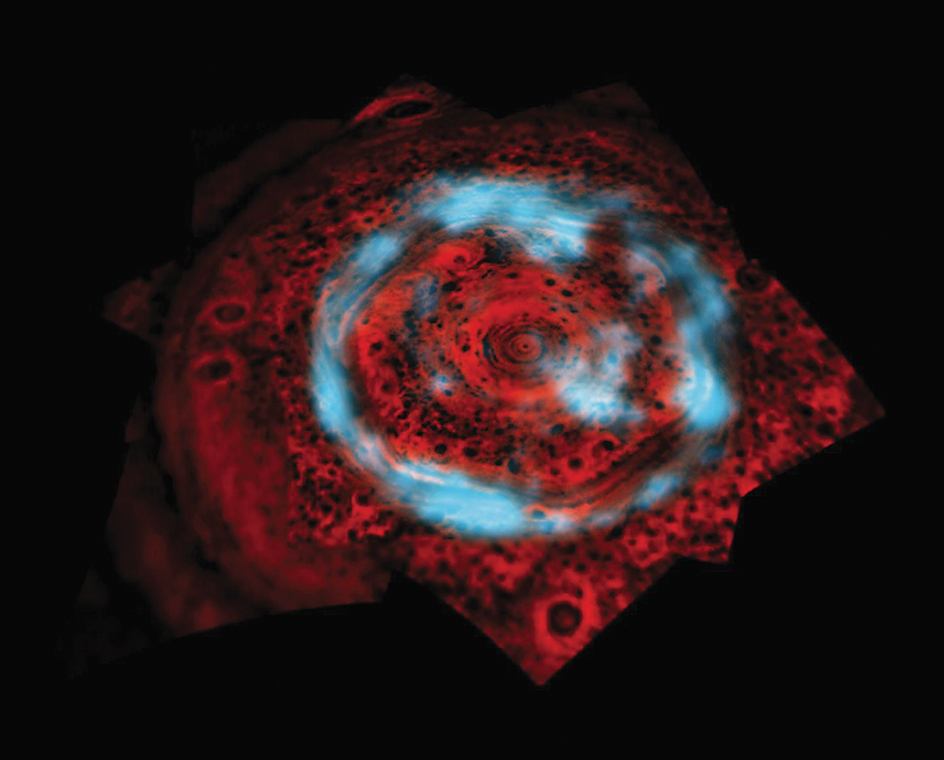Saturn is a planet known for its gleaming rings. Saturn also ranks as the second largest planet in the solar system. Only Jupiter is larger. Saturn is the sixth planet from the sun. It was the farthest planet from Earth known to ancient observers. Saturn gets its name from the ancient Roman god of agriculture (see Saturn).
Saturn can be seen from Earth with the unaided eye, but its rings cannot. Viewed through a small telescope, the planet appears as a hazy yellow globe with few visible features. The rings appear as a thin, flat disk.
Saturn’s rings consist of ice particles that travel around the planet. It has seven main rings, which vary greatly in width. The outermost ring, called the E ring, may measure more than 180,000 miles (300,000 kilometers) across. But the rings are so thin that they cannot be seen with Earth-based telescopes when their edge is in direct line with Earth. The rings vary greatly in thickness. Most are probably under 100 feet (30 meters) thick.
In addition to the rings, Saturn has several large, fascinating moons and dozens of smaller satellites. Saturn’s largest moon, Titan, has an atmosphere thicker than that of Earth. Another moon, Enceladus, is geologically active. Erupting geysers on Enceladus spew water ice and organic molecules into space. The planet, together with its moons, rings, and magnetosphere, is sometimes called the Saturn system. The magnetosphere is a region of space dominated by Saturn’s magnetic influence.
The exploration of Saturn by spacecraft began with the flyby of Pioneer 11 in 1979. The twin Voyager 1 and 2 space probes passed through the Saturn system in 1980 and 1981. The space mission Cassini, launched in 1997, orbited Saturn from 2004 to 2017. The Huygens probe was dropped by Cassini in late 2004. The probe touched down on Titan’s surface in 2005.
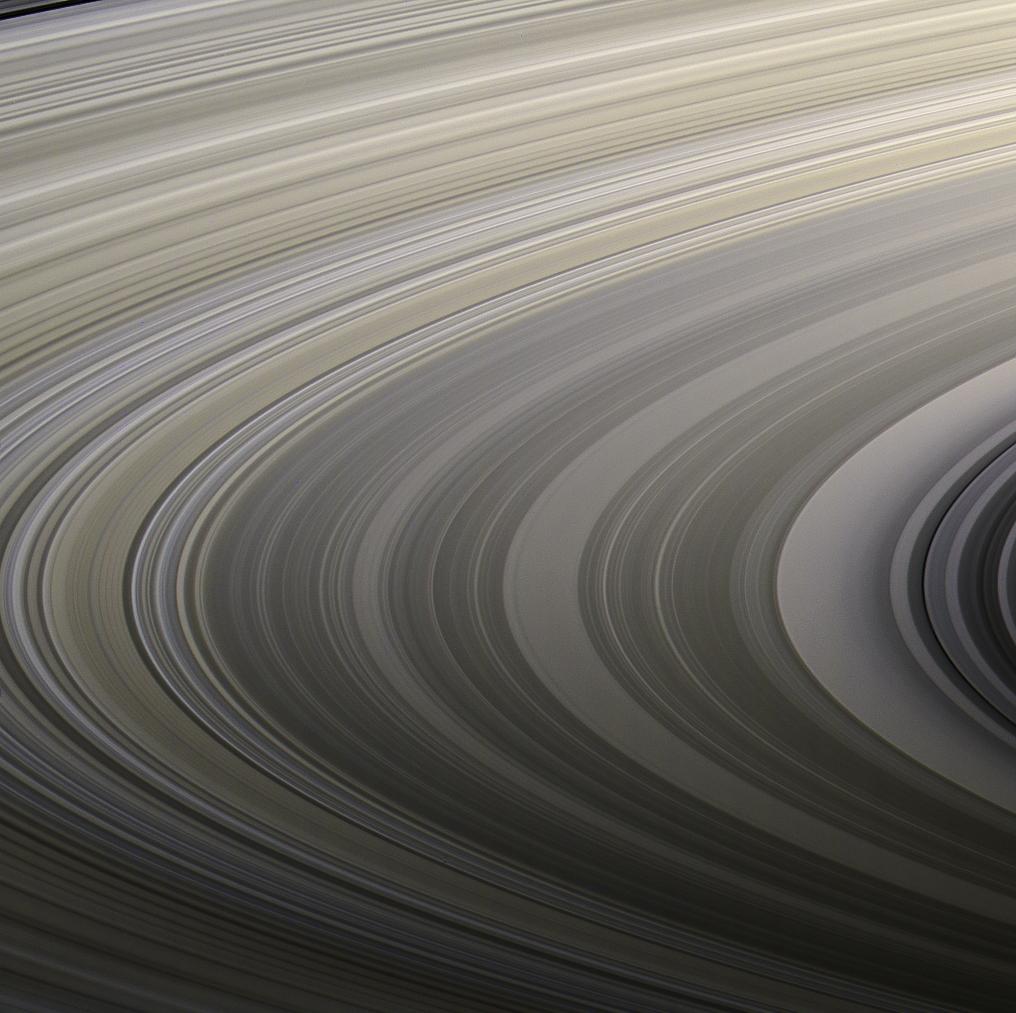
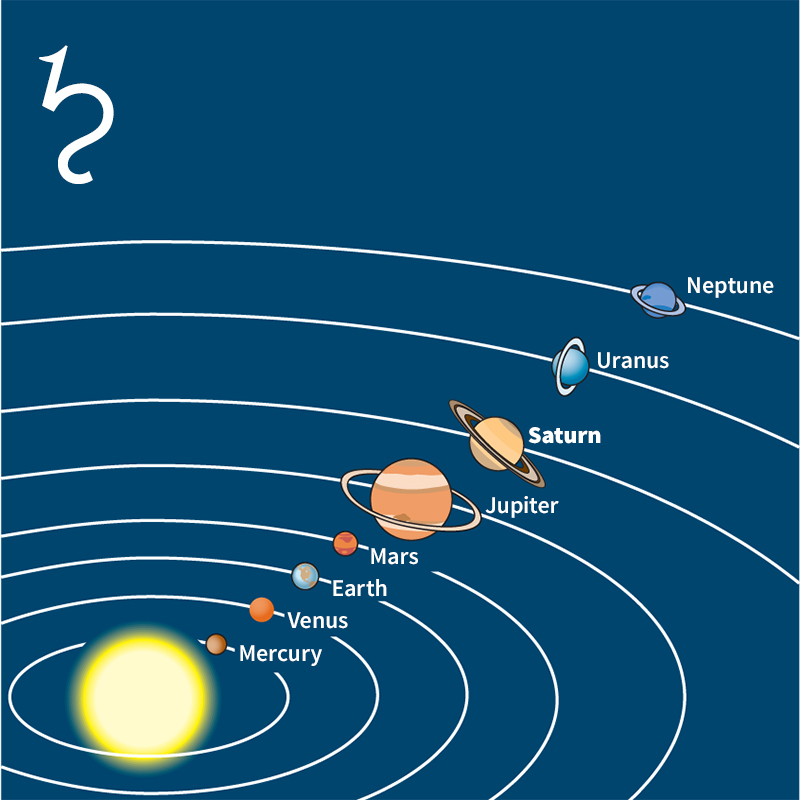
Characteristics
Astronomers have determined the basic characteristics of Saturn through observations by telescope and spacecraft. Saturn’s mass (amount of matter), density (mass divided by volume), and gravitational pull all suggest that the planet is a giant ball of hydrogen and helium. It probably has no solid surface.
Size.
Saturn’s diameter at its equator is about 74,900 miles (120,500 kilometers). That diameter is more than nine times that of Earth and about 85 percent that of Jupiter. Saturn has more than 760 times Earth’s volume.
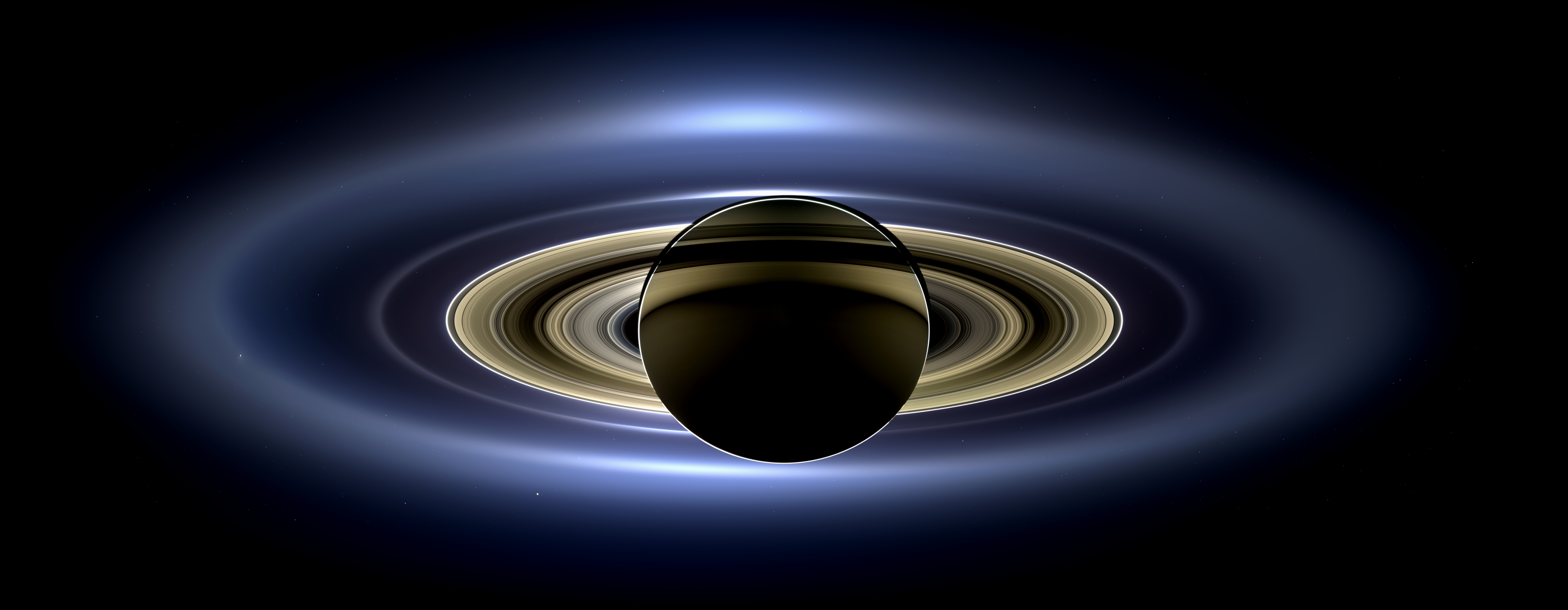
Mass and density.
Despite its huge size, Saturn has only 95 times Earth’s mass. Thus, its density is only about one-eighth that of Earth. Saturn’s density is less than that of liquid water. Saturn has a lower density than any other planet in the solar system. Its density is just over half that of Jupiter.
Saturn still has more mass, however, than any other planet in the solar system except Jupiter. Jupiter has more than three times Saturn’s mass. The difference in mass results in the large difference in density between the two planets. Hydrogen and helium are highly compressible. That means they are easily squeezed to a greater density. The greater mass of Jupiter squeezes the hydrogen and helium much more than does that of Saturn, leading to Jupiter’s larger density.
Due to Saturn’s low density, the gravitational pull of Saturn is similar to Earth’s. A 100-pound (45-kilogram) object on Earth would weigh about 107 pounds on Saturn (the equivalent of about 49 kilograms on Earth).
Orbit.
Saturn orbits the sun at an average distance of about 890,750,000 miles (1,433,530,000 kilometers). Earth, in comparison, orbits at an average distance of about 92,960,000 miles (149,600,000 kilometers). Saturn takes about 29 1/2 Earth years to complete one orbit.
Saturn’s orbit is elliptical (oval-shaped). The planet’s distance from the sun varies from about 941,070,000 miles (1,514,500,000 kilometers) at its farthest point to about 840,440,000 miles (1,352,550,000 kilometers) at its closest point. At its closest approach to Earth, Saturn is about 742,800,000 miles (1,195,500,000 kilometers) away.
Rotation.
As Saturn travels around the sun, it spins on its axis. The planet’s axis is an imaginary line connecting its poles. Saturn’s axis is tilted about 27 degrees from upright, in relation to its orbit. This tilt is a bit more than Earth’s tilt of 23 degrees.
Saturn rotates faster than any other planet in the solar system except Jupiter. Saturn’s atmosphere obscures a direct measurement of its rotation. But indirect measurements indicate that the planet spins around once in about 10 hours 33 minutes. This time is the length of a day on Saturn. The rapid rotation causes Saturn to bulge at its equator and to flatten at its poles. For this reason, the diameter of Saturn is about 7,337 miles (11,808 kilometers) larger at the equator than between the poles.
Temperature.
Saturn’s tilt causes the sun to heat the planet’s northern and southern halves unequally. The uneven heating results in temperature changes and seasons. The actual temperature also varies with altitude. At an elevation where the atmospheric pressure is one bar, Saturn averages –218 °F (–139 °C).
Structure
Scientists have constructed a model of Saturn’s structure based on the behavior of hydrogen and helium at high pressures. The evidence suggests that the atmosphere hides a liquid interior and a solid core.
Atmosphere.
A dense layer of clouds covers Saturn. Photographs of the planet show bands of varied colors on the cloud tops, called belts and zones. This banded appearance seems to be caused by differences in temperature and altitude among rising and falling gases.
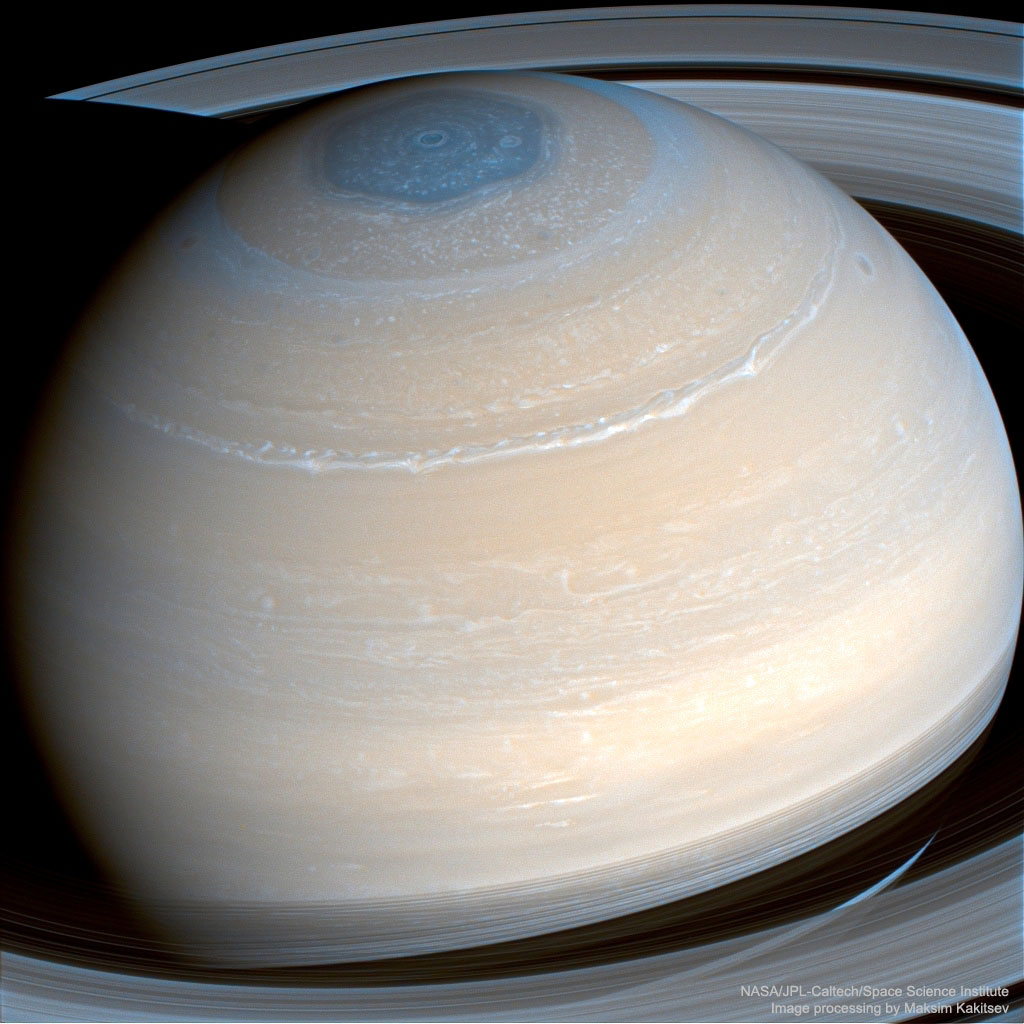
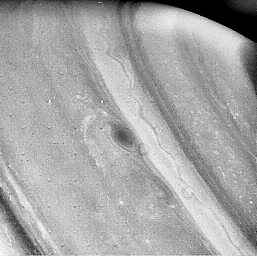
The general haziness of Saturn’s atmosphere makes observing its features difficult. At infrared wavelengths—wavelengths longer than visible light—the haze disappears and the deeper atmosphere is visible. Infrared images taken by the Cassini orbiter show a highly unstable atmosphere with many rotating features. These features somewhat resemble storm systems on Earth. Winds on Saturn have been clocked at up to 1,100 miles (1,770 kilometers) per hour, much faster than on Jupiter. Scientists have also detected lightning in Saturn’s atmosphere.
Saturn receives about 1 percent of the amount of sunlight that Earth does. However, it gives off about two times as much energy as it receives. Some of this energy may be heat created as Saturn contracts under the influence of gravity. Another source of heat may be caused by helium, deep below the surface of Saturn, forming rain drops and falling farther into the center of Saturn.
Like all of Saturn, the atmosphere consists primarily of hydrogen and helium. The atmosphere also contains traces of water, ammonia, methane, and other compounds.
Interior.
Descending through Saturn’s atmosphere, the pressure of gases grows steadily. Hydrogen and helium take on a more viscous (thick) form. Eventually, they merge with the planet’s liquid interior. Saturn’s interior may have a layer of highly compressed, liquid metallic hydrogen. Such hydrogen has taken on some metallic properties under extreme pressures and temperatures.
Core.
Saturn’s spin, shape, and gravitational pull suggest that the planet has a hot, solid inner core. The core probably consists of carbon, iron, oxygen, silicon, and other elements heavier than hydrogen and helium.
Rings
Saturn’s seven main rings surround the planet at its equator but do not touch it. They consist mainly of pieces of ice, ranging from dust-sized grains to chunks more than 10 feet (3 meters) in diameter. Many of the rings feature thin bands of varying brightness, called ringlets. Gaps of several thousand miles or kilometers separate most of the major rings. The gaps contain fewer particles than the rings. Some of the gaps have ringlets. In addition to the major rings, the ring system includes numerous diffuse (thinly spread) ringlets and small moons. Gravitational interactions between Saturn’s inner satellites and the ring particles play a major role in maintaining the structure of the rings, ringlets, and gaps.

Astronomers have assigned letters to the major rings, based roughly on the order of the rings’ discovery. From the closest to Saturn to the farthest away, they are the D, C, B, A, F, G, and E rings. The A, B, C, and D rings each consist of thousands of ringlets.
The A and B rings are the brightest. A dark gap called the Cassini Division separates the two. The gravitational influence of Saturn’s moon Mimas keeps the Cassini Division relatively free of particles. Mimas lies inside the E ring. The moon orbits Saturn once for every two orbits of the particles in the Cassini Division. This simple 2 to 1 ratio results in what is called a 2:1 orbital resonance between the ring particles and the moon. The resonance produces specific gravitational interactions between the moon and the particles, forcing particles out of the Cassini Division. The outer edge of the A ring is maintained by a 7:6 orbital resonance between the ring particles there and the moons Janus and Epimetheus. Within the A ring is a gap, called the Encke gap. It is caused by the presence of the small moon Pan. Pan orbits within the ring, clearing ring particles from its path. The fainter C and D rings lie inside the B ring.
The bright F ring lies just outside the A ring. The F ring consists of a narrow band of ringlets that lie between the orbits of the satellites Prometheus and Pandora. The moons’ gravitational pulls confine or “herd” the particles of the F ring into a narrow band. Because of this herding, astronomers sometimes refer to these satellites as shepherd moons. At certain points in Prometheus’s eccentric (oblong) orbit, the moon actually enters the ring. Where the moon enters, its gravitational pull creates “kinks” in the ring. The kinks give the F ring a braided appearance.
The faint E and G rings are much thicker than the inner rings. Their particles are spread more thinly. The E ring consists mainly of microscopic particles. Scientists have determined that some of the ring’s particles come from geysers on the moon Enceladus. The G ring is thinner than the E ring and contains larger particles. Astronomers think these particles may be dust spreading out from a ring arc (curved region of debris) held in its orbit by the gravity of Mimas. 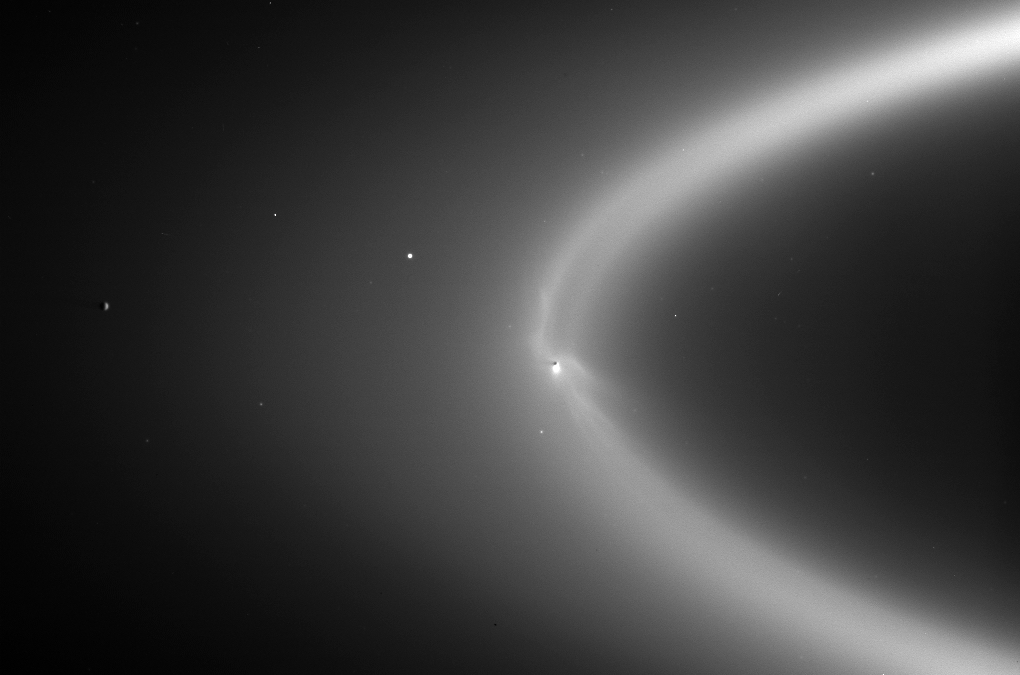
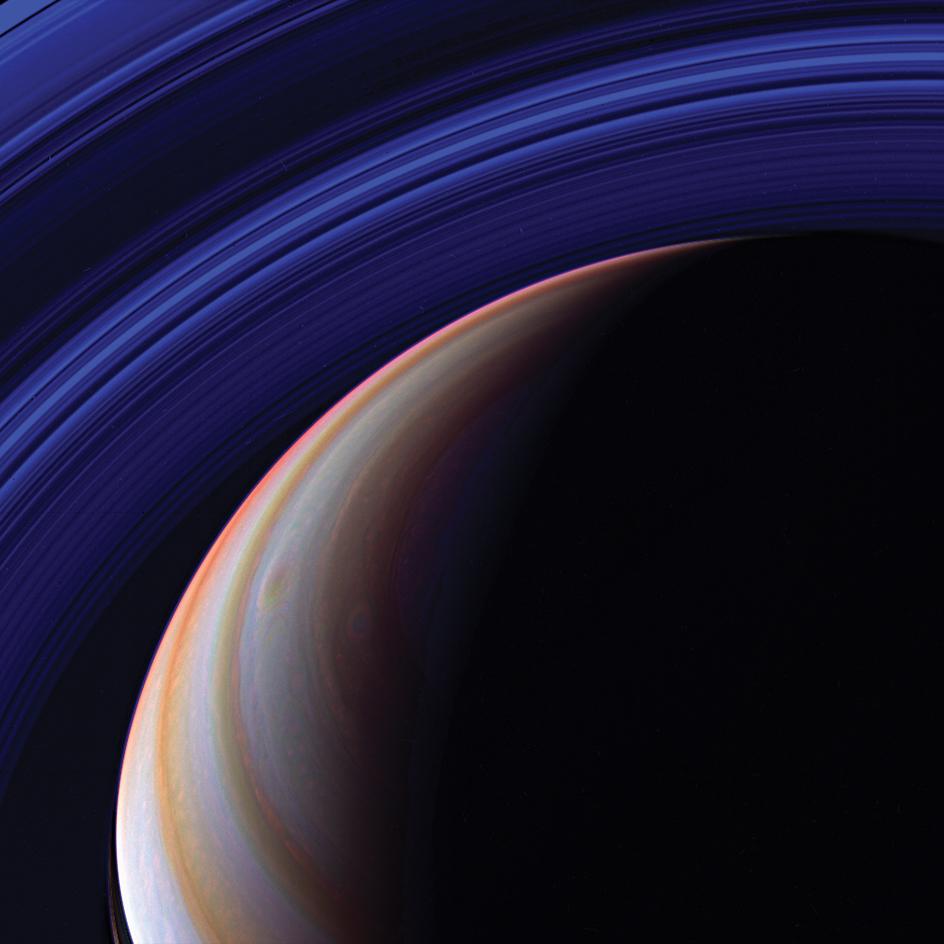
Beginning with the Voyager missions, astronomers noticed dark markings reaching out from the center of the B ring, called spokes. The spokes appear to result from fine dust being raised above the main ring by electrical and magnetic forces. However, the details of their formation remain poorly understood.
In 2009, scientists using the Spitzer Space Telescope discovered a diffuse doughnut-shaped ring far beyond the orbit of the previously known rings. The ring is centered around the orbit of the moon Phoebe. The ring is roughly 8 million miles (13 million kilometers) thick.
Satellites
Astronomers have identified at least 146 satellites of Saturn. Many more may await discovery. The largest 8 moons were the first discovered.
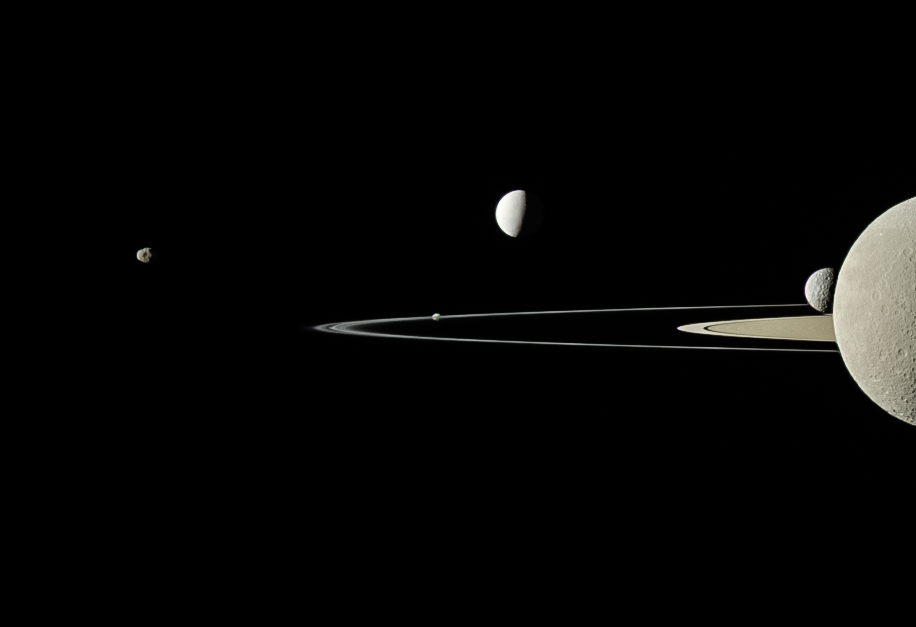
The largest of Saturn’s satellites, Titan, has a diameter of about 3,200 miles (5,150 kilometers). Titan’s diameter is larger than that of the planet Mercury. Titan is the only satellite in the solar system with a significant atmosphere. In fact, Titan’s atmosphere is 4 times denser at the surface than is Earth’s atmosphere. Titan’s atmosphere consists largely of the gas nitrogen. The second most abundant gas is methane. Methane high in Titan’s atmosphere is broken apart by sunlight and by charged particles from Saturn’s magnetosphere. The fragments recombine to form a variety of carbon- and nitrogen-bearing molecules called hydrocarbons and nitriles. These molecules are of interest to scientists because they serve as some of the basic building blocks of life. Like several of Jupiter’s moons, Titan is also thought to have an ocean of liquid water deep beneath its surface.
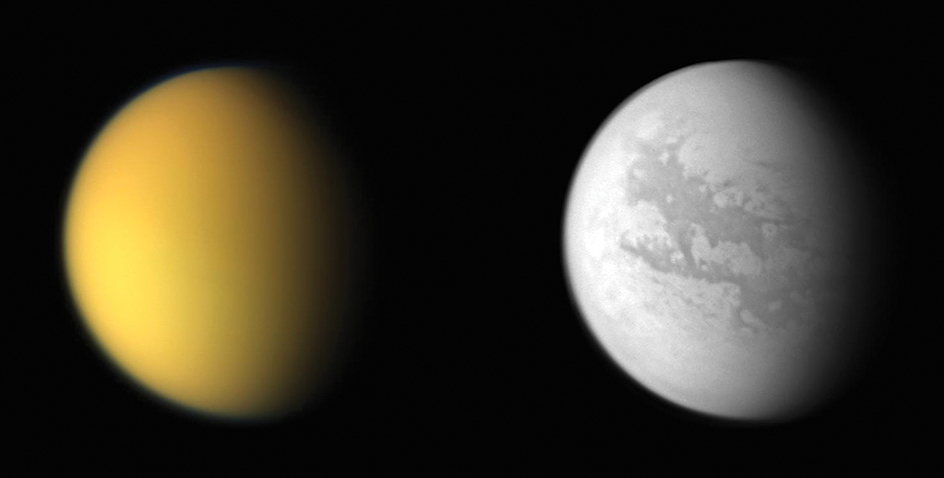
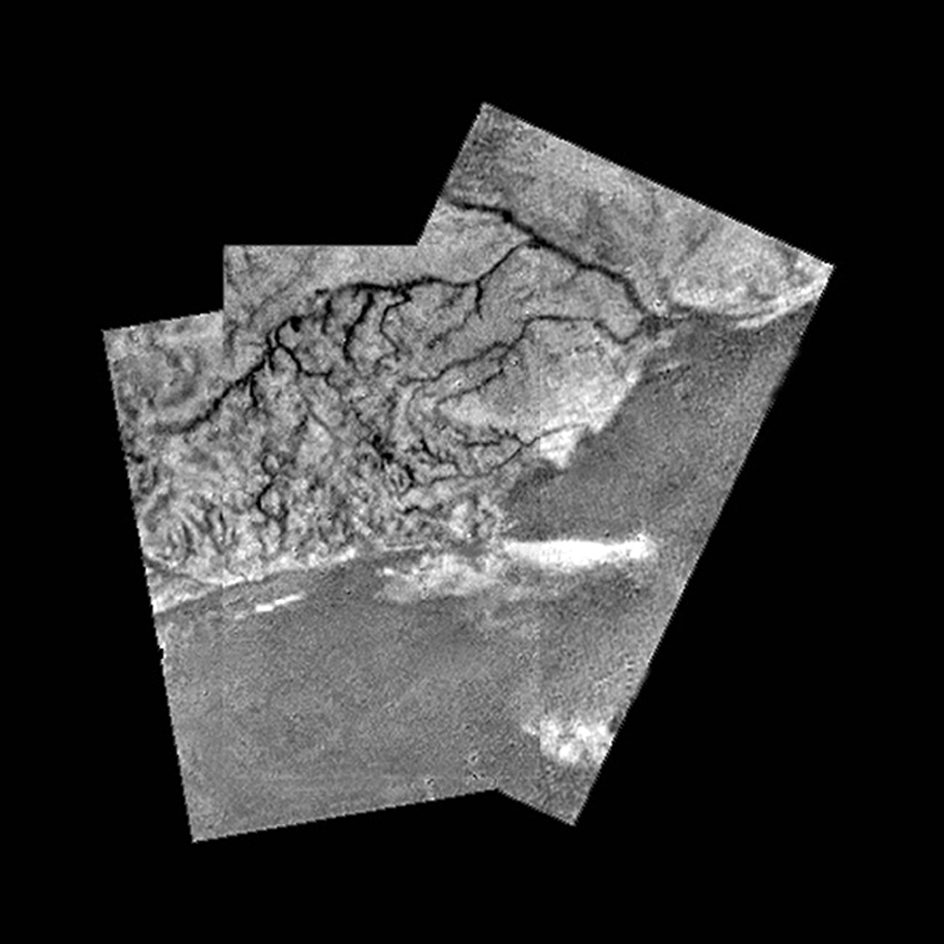
The Huygens probe descended to Titan by parachute in 2005, after the Cassini orbiter released it in late 2004. As the probe fell, it observed channels in the slopes of an icy hillside near its landing site. These channels appear to have been carved by a flow of liquid, most likely methane. Methane, typically a gas on Earth, is stable as a liquid on Titan’s surface. Another stable liquid on Titan is ethane. Both ethane and methane have been observed to form clouds in Titan’s atmosphere. The Cassini orbiter photographed lakes and seas on Titan’s surface. These lakes and seas are made of a mixture of ethane and methane. Observations show that these lakes and seas change size over time. Some scientists believe the lakes grow and shrink with changes in the seasons. Images produced by Cassini have also revealed evidence of cryovolcanism (eruptions of melted ice) on Titan.
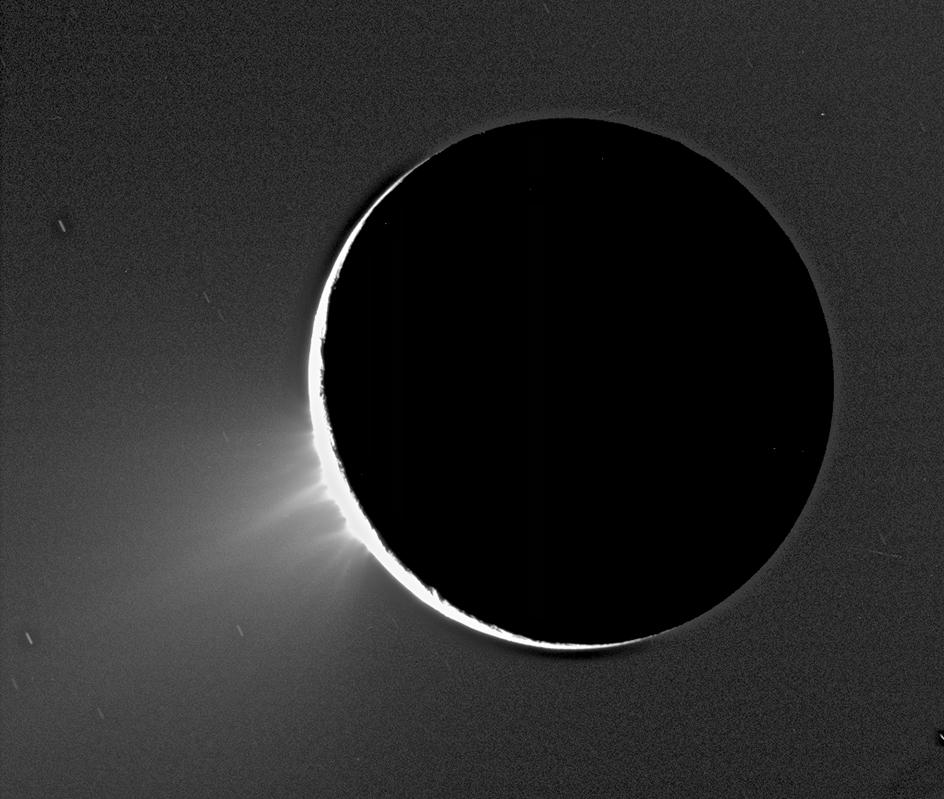
Mimas’s distinguishing feature is the single impact crater that dominates its surface. The impact crater is named Herschel after the moon’s discoverer, the British astronomer Sir William Herschel. The crater was formed by an impact so large it almost broke the moon into pieces.
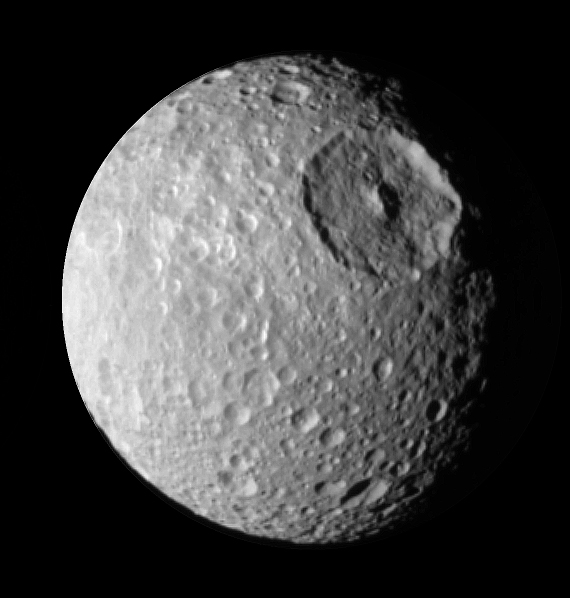
Tethys also has an unusually large single impact crater. This moon shares its orbit around Saturn with two smaller moons, Telesto and Calypso. Telesto orbits ahead of Tethys, and Calypso orbits behind it, both at an equal distance. The combined gravitational pulls of Tethys and Saturn hold Telesto and Calypso at these special positions, known as Lagrange points.
Dione also shares its orbit with two smaller moons, Helene and Polydeuces. Helene orbits ahead of Dione, and Polydeuces orbits behind Dione, both near the Lagrange points of Dione and Saturn.
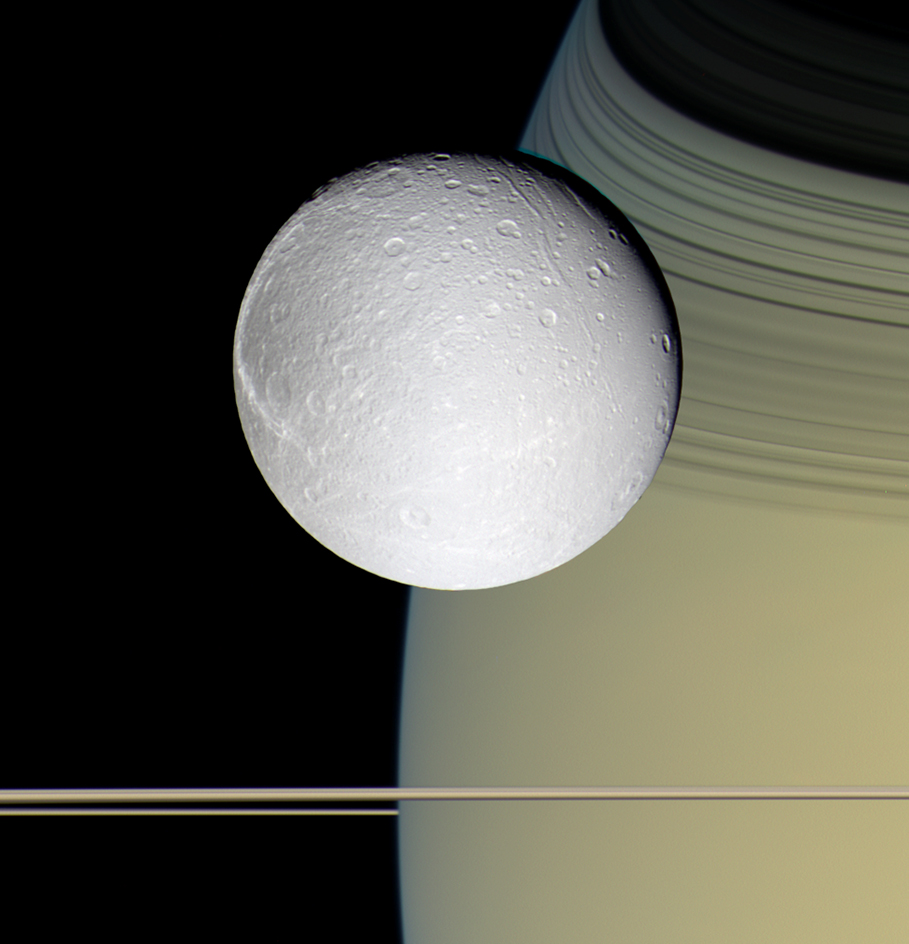
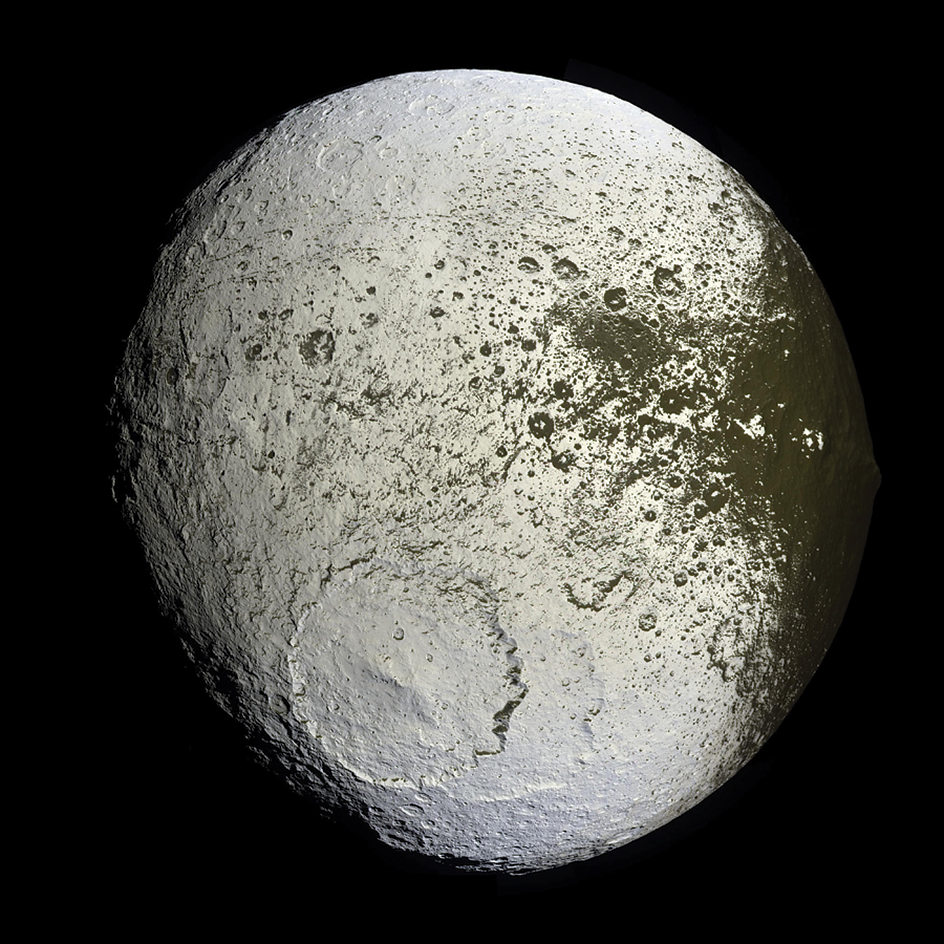
Rhea is similar in appearance to several of the other large moons. It has a dull, mostly uniform, gray surface with a few white streaks. In 2010, Cassini detected an exosphere, an extremely thin atmosphere surrounding the moon. The exosphere consists of oxygen and carbon dioxide.
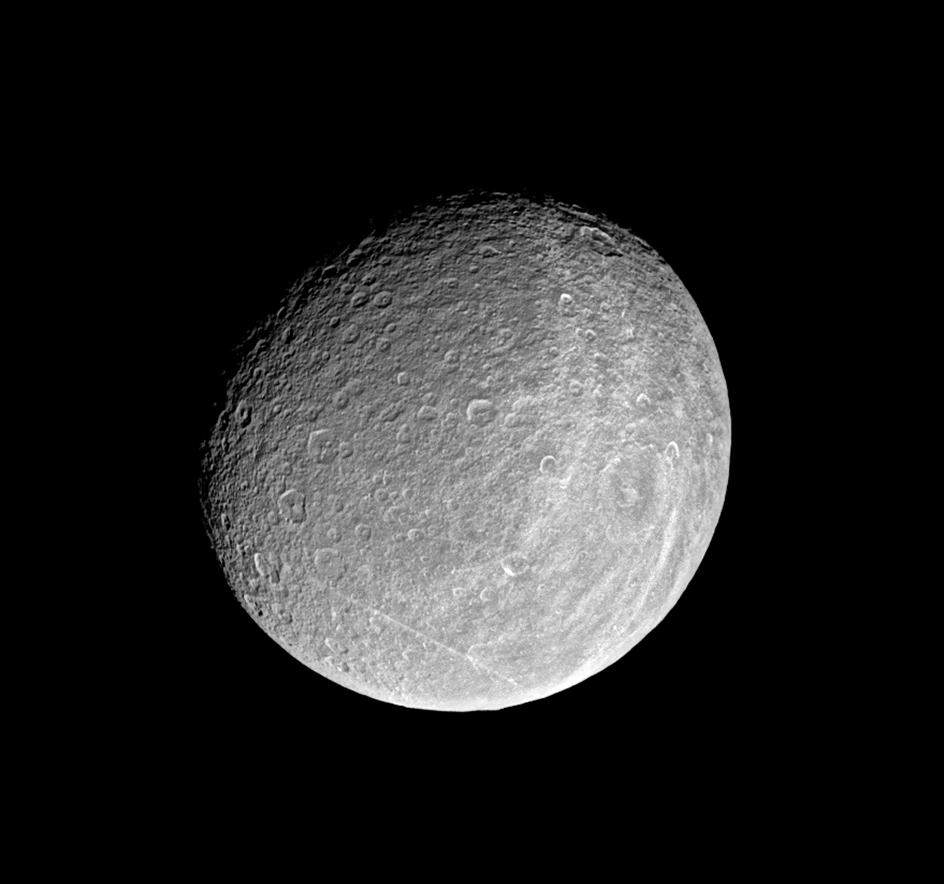
Hyperion is shaped like a squat cylinder rather than a sphere. Unlike Saturn’s other satellites, Hyperion’s axis does not point toward the planet.
Most of Saturn’s other moons are much smaller. Many have irregular shapes and elongated orbits.
History of study
In 1610, the Italian astronomer Galileo Galilei discovered Saturn’s rings using one of the first telescopes. Galileo could faintly see bulges of the rings on each side of the planet. But he could not distinguish their true nature. Instead, he concluded that the bulges were two large satellites. In 1656, using a more powerful telescope, the Dutch astronomer Christiaan Huygens described a “thin, flat” ring around Saturn. Huygens thought the ring was a solid sheet of some unknown material. In 1675, the Italian-born French astronomer Giovanni Domenico Cassini discovered that the single ring was actually two. The two rings are now known as the A and B rings. Cassini correctly guessed that the rings were made up of swarms of satellites. Later observations resulted in the discovery of the other rings. Beginning in the 1970’s, observations by spacecraft revealed the complex structure of the rings and the influences that shape them.


In 1973, the United States launched the space probe Pioneer 11 to study both Saturn and Jupiter. Pioneer 11 flew within 13,000 miles (20,900 kilometers) of Saturn on Sept. 1, 1979. The data and photographs sent back to Earth led to the discovery of the F ring. The data also suggested the existence of the G ring. Pioneer 11 found that the planet has a magnetic field (region of influence exerted by a magnetic object). The probe also discovered belts of radiation inside the planet’s magnetosphere. The belts consist of high-energy electrons and protons. They are comparable to Earth’s Van Allen belts.
In 1977, the United States launched two space probes, Voyager 1 and Voyager 2, to study Saturn and other planets. Voyager 1 flew within 77,000 miles (124,000 kilometers) of Saturn on Nov. 12, 1980. On Aug. 26, 1981, Voyager 2 flew within 63,000 miles (101,000 kilometers) of the planet. The Voyager probes confirmed the existence of Saturn’s G ring. They also found that the planet’s rings are made up of ringlets. In addition, the probes sent back data and photographs that led to the discovery or proved the existence of nine satellites. The Voyager probes determined that the atmosphere of Titan consists chiefly of nitrogen. 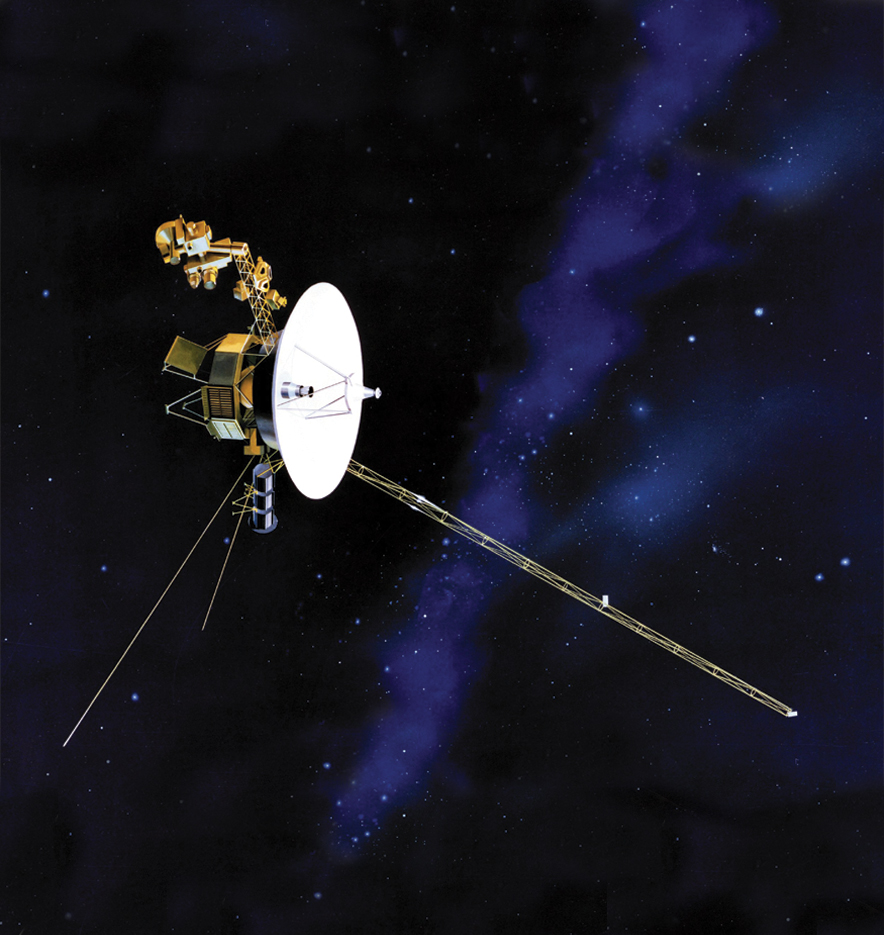

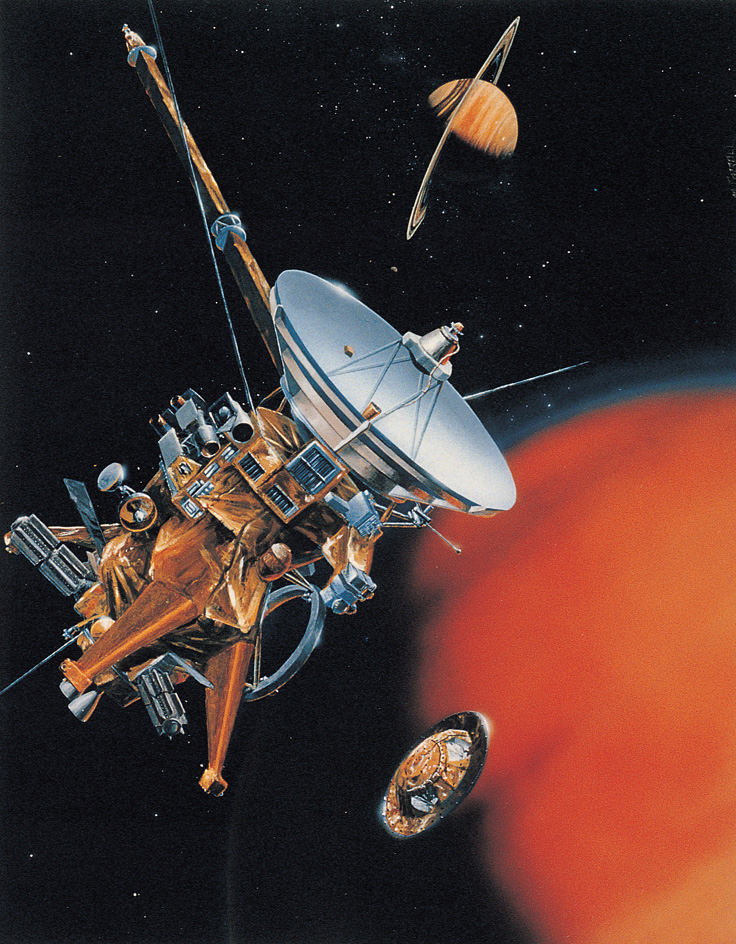
In 1997, the United States launched the Cassini probe to study Saturn, its rings, and satellites. The probe began orbiting Saturn in 2004. Images taken by Cassini showed waves of varying density in some of Saturn’s rings. These waves are caused by the gravitational pull of the inner satellites. The probe also discovered new details of Saturn’s weather and a variety of geologic features on Saturn’s largest moons.
In 2006, scientists studying images taken by Cassini found small propeller-shaped gaps in the A ring. The gaps were apparently created by bodies about 130 to 390 feet (40 to 120 meters) in diameter. These “moonlets” are too large to have accumulated from particles. Their presence supports the theory that the rings formed from a moon-sized body that broke apart. Cassini also discovered the locations of the active geyser systems of Enceladus.
